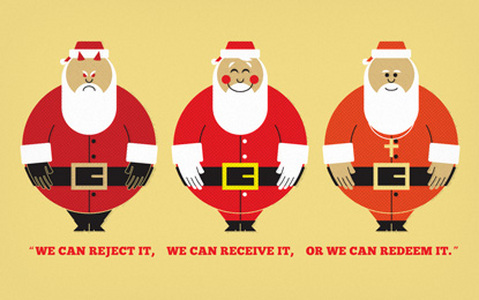The article explained that we have three choices when it comes to explaining Santa Claus to our children: 1) We can reject it (i.e. Satan Claus and telling our children he's a horrible lie meant to distract us from Jesus' birth), 2) We can receive it (i.e. basically the traditional telling our children Santa Claus is a jolly old man who leads a team of flying reindeer on Christmas Eve to deliver the toys his elves made), and 3) We can redeem it (i.e. telling our children the truth about St. Nicholas and allowing Santa Claus to remind us of him).
Greg and I have chosen to redeem Santa Claus. We tell our kids that Santa Claus was a real person who lived a long time ago. We explain that people dress up as Santa and pretend to be him for fun, kind of like how they dress up like a monkey, angel, doctor, etc. on Halloween. (See my post on Redeeming Halloween for more on that topic.) We explain how, in addition to the actual story of Santa, a lot of other stories have been added (i.e. flying reindeer, living in the North Pole, elves, delivering presents to every child in one night) so that the traditional Santa is a combination of true and make-believe stories.
We do not demonize Santa, but we do not lie to our children either. We teach Christian and Abbie that they can always trust us and we will never lie to them, and we ask that they be honest with us and never lie. Since we also teach our children that Jesus is a real person who did perform real miracles, our fear is that if we teach them fanciful, make-believe stories as truth, it could erode confidence in our truthfulness where it really matters. So, we distinguish between lies, secrets, surprises, and pretend for our kids. We ask them not to tell lies, but do teach them that some surprises (like gift-giving) and pretending (like dressing up) can be fun and should be encouraged. We tell them the truth and encourage them to have fun watching Christmas shows on television and even sitting on Santa's lap for a holiday photo if they so desire.


Over the years we have also had to teach our children how to handle the fact that many of their friends believe in Santa Claus. We have told our children not to correct their friends when they talk about Santa Claus because their parents are having fun allowing them to use their imaginations. We have also told them that if a friend directly asks them whether or not they believe Santa Claus is real then they should tell the truth that St. Nicholas was a real man and Santa Claus helps remind us of him.
The truth is that the myths surrounding Santa Claus actually emanate from the very real person of Saint Nicholas. It is difficult to know the exact details of his life with certainty, as the ancient records are sparse, but the various pieces can be put together as a mosaic of his life.
Nicholas was born in the third century in Patara, a village in what is now Turkey. He was born into an affluent family, but his parents died tragically when he was quite young. His parents had raised him to be a devout Christian, which led him to spend his great inheritance on helping the poor, especially children. He was known to frequently give gifts to children, sometimes even hanging socks filled with treats and presents.
Perhaps his most famous act of kindness was helping three sisters. Because their family was too poor to pay for their wedding dowry, three young Christian women were facing a life of prostitution until Nicholas paid their dowry, thereby saving them from a horrible life of sexual slavery.
Nicholas grew to be a well-loved Christian leader and was eventually voted the Bishop of Myra, a port city that the apostle Paul had previously visited (Acts 27:5-6). Nicholas reportedly also traveled to the legendary Council of Nicaea, where he helped defend the deity of Jesus Christ in A.D. 325.
Following his death on December 6, 343, he was canonized as a saint. The anniversary of his death became the St. Nicholas holiday when gifts were given in his memory. He remained a very popular saint among Catholic and Orthodox Christians, with some two thousand churches named after him. The holiday in his honor eventually merged with Christmas, since they were celebrated within weeks of one another.
During the Reformation, however, Nicholas fell out of favor with Protestants, who did not approve of canonizing certain people as saints and venerating them with holidays. His holiday was not celebrated in any Protestant country except Holland, where his legend as Sinterklass lived on. In Germany, Martin Luther replaced him with the Christ child as the object of holiday celebration, or, in German, Christkindl. Over time, the celebration of the Christ child was simply pronounced Kris Kringle and oddly became just another name for Santa Claus.
The legends about Santa Claus are most likely a compilation of other folklore. For example, there was a Siberian myth (near the North Pole) that a holy man, or shaman, entered people's homes through their chimneys to leave them mushrooms as gifts. According to the legend, he would hang them in front of the fire to dry. Reindeer would reportedly eat them and become intoxicated. This may have started the myth that the reindeer could fly, as it was believed that the shaman could also fly. This myth may have merged with the Santa Claus myth, and if so, explains him traveling from the North Pole to slide down chimneys and leave presents on fireplace mantles before flying away with reindeer.
These make-believe stories of Santa Claus were first brought to America by Dutch immigrants (yes - my hubby's descendants - shame on them ;). In the early twentieth century, stores began having Santa Claus present for children during the Christmas season. Children also began sending letters to the North Pole as the legends surrounding an otherwise simple Christian man grew.
In summary, Saint Nickolas was a wonderful man who loved and served Jesus faithfully. So, we are going to gladly include him in our Christmas traditions to remind us of what it looks like for someone to live a life of devotion to Jesus and give generously. We hope that through all this we will be honest, fun, and Christ-honoring parents.

